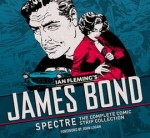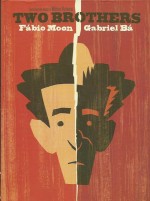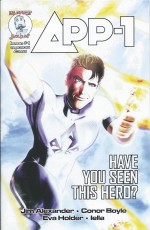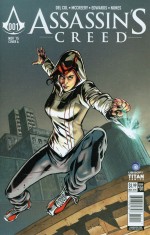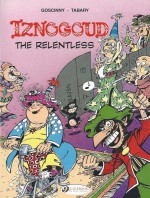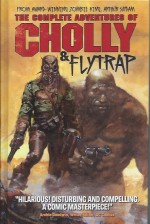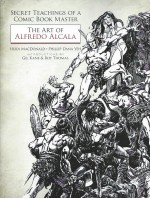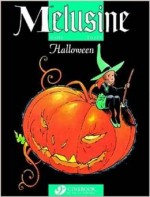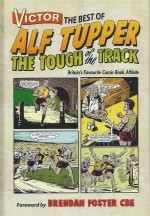
By various anonymous and Peter Sutherland, introduced by Morris Heggie (Prion Books)
ISBN: 978-1-85375-861-4
Win’s Christmas Gift Recommendation: Better than a Boxing Day kick-about… 8/10
If you grew up British anytime after 1960 and read comics you probably cast your eye occasionally – if not fanatically – over DC Thompson’s venerable “Boy’s Paper†The Victor. The Dundee based company has long been a mainstay of British popular reading and its strong editorial stance has informed and influenced a huge number of household names over the decades.
Post-WWII, Victor was very much the company’s flagship title for action and adventure and featured amongst its grittily realistic pantheon of ordinary stars a perpetually grimy, soot-stained, incorrigibly working class sportsman called Alf Tupper; forever immortalised as The Tough of the Track.
Gathered here in another superb hardcover compilation commemorating the truly unique DC Thomson comics experience is a splendid collection of the Running Man’s most impressive exploits, reproduced in the company’s traditional and splendidly evocative two-colour print process.
The main tenet of the Thomson adventure philosophy is a traditional, humanistic sense of decency. Talented and determined distance runner Tupper might be a poor, rough, ill-educated working lad, competing in a world of privileged “Toffee-Nosed Swellsâ€, but he excels for the sheer joy of sportsmanship, not for gain or glory.
He’s the kind of man most decent folk used to want their kids to grow up into…
Hugely friendly, helpful and big-hearted, Alf first appeared in 1949 in a continuing series of prose stories in “Boys Story-Paper†The Rover. He was created by Bill Blaine and the majority of his exploits were written by Gilbert Lawford Dalton with single illustrations by Len Fullerton, Ian McKay, Fred Sturrock, Jack Gordon, George Ramsbottom, Calder Jamieson and James “Peem†Walker.
By the end of the 1950s the publishers were finally accepting that their readers no longer wanted all-prose periodicals, and comic strips were the only way to go. Alf was retooled as just such a pictorial headliner and transferred to The Victor where he persevered until the publication folded. His last appearance was in 1992 in The Sunday Post. He was training for the then-imminent Barcelona Olympics…
Common, rowdy, earthy and perpetually sticking it to the posh-boys who monopolised athletics, Tupper was also one of the greatest distance runners alive and fought prejudice, discrimination, poverty and especially privilege as he won races, medals and accolades.
When he wasn’t running or eating fish and chips, Alf was an accomplished welder in the northern industrial town of Greystone, originally apprenticed to shifty, shiftless Ike Smith before eventually setting up in business for himself.
The lad was all about determination countering ill-fortune, adversity – or even enemy action – and he just hated to be beaten. When he occasionally was, he didn’t dwell on excuses, but resolved to win the rematch…
The True Brit sporting legend apparently had a big influence on the development of many of our actual sporting greats, as seen from the ‘Foreword by Brendan Foster CBE’ and the background-stuffed ‘Introduction by Morris Heggie’ before the profusion of confusingly untitled treats begin – all apparently taken from assorted Victor Book for Boys Christmas Annuals and primarily illustrated by the superb and criminally un-acclaimed Peter Sutherland.
The initial tale finds Alf training in the wee small hours along Greystone’s grimly cobbled streets. As he tells a wary beat copper, he is snatching what time he can because he has a rush job on but still needs to keep in shape for the Fenfield Mile where Olympic hopeful Guy Granger is in competition…
The pace proves just too much and on the day Granger – a typical spoiled rich-boy – just pips Alf at the tape. When they meet again in a record race at White City, the Tough makes certain this race goes his way…
General picture quiz ‘A Question of Sport’ then leads neatly into another epic Tough of the Track tale as Ike ruins Alf’s leisurely trip to London (where he is entered in the 10,000 Metres at the European Championships) by putting his affable apprentice on a rush welding job.
Forced to travel down on a milk train after hours of intense toil, Tupper is suckered by the devious tactics of the Nuroslavian champion Sturmer and has to settle for silver, but when a team-mate competing in the 5,000 Metres is injured, the now-rested Tough gets another shot at a gold medal…
Another time, whilst hitching to a Mile race in Northcastle Alf discusses with the driver how he wants to run against National hope Harold Pilkington, but on arrival finds the devious rich boy refusing to compete. Terrified of being shown up, the sneaky snob is completely unwilling to compete in a fair race but cannot weasel out when Tupper finds employment in his father’s factory just so he can “run him†at the annual Works Sports Day…
When a vagrant wind blows Alf’s fish supper wrappings away from a bin, he falls foul of a litter-crazed policewoman, but later appreciates her stance after he steps on broken glass obscured by trash and is forced to quit running for a fortnight. At least he would have if there wasn’t a race that Saturday…
Now just as obsessed, he spends the rest of his recuperation cleaning up the streets and making litter-louts behave themselves, but almost loses his next race when he stops in the final stretch to pick up paper blown onto the track…
Another last-minute welding job almost ruins his shot at the international “Mile of the Centuryâ€. Oddly enough, the much-touted exhibition match is a dull affair because the other three contestants are equally debilitated for various reasons.
With the competitors as disappointed as the fans, Alf’s cheeky suggestion that they all enter for a local amateur Mile near the airport before flying home is met with huge enthusiasm and really pays off the local fans…
One of the most well-regarded Tupper tales follows as the Tough overcomes all manner of pedestrian obstacles in his efforts to race again against mythic Iron Curtain running star Fedor Oranski. When their epic dash at White City resulted in a dead heat the great man invited his young rival to a return match in distant, dangerous totalitarian Rakovia.
After getting his savings out and finagling a visa, the poor oaf is pick-pocketed at the airport and, rather than give in, stows away and enters the dictatorship illegally. Only a fortuitous last-second intervention by Oranski stops our kid ending up in a gulag or worse but at least this time when they run there’s a clear winner…
Tupper’s character and demeanour were again a problem for some people when he was invited to join top British athletes at select training camp Granton Hall. Despite his winning all the time, the snooty trainer – a former naval officer – objected to Alf’s attitude, discipline and apparent lack of team spirit…
It resulted in him being dropped from the official British squad for a major international cross country event, but Alf simply competed as an independent, even though in the days before the race he was hospitalised after saving a man who had crashed his vehicle and become lost in a blizzard…
A few tales have individual story titles. ‘The Winner Came in Eighth’ saw the runner targeted by the unscrupulous trainers of a leading French competitor who initially try to bribe and then simply kidnap Alf in advance of a big international race. This leads to a broadside of humorous sporting facts in ‘Football Fun’ before ‘The Tough of the Team’ finds the working-class hero in contention with an obnoxious American running for Granton Hall who takes an instant dislike to Alf and isn’t above employing dirty tricks to win.
When Tupper is invited to run for the prestigious Old Milocarians against Granton, he has his chance for revenge but almost loses everything when he sacrifices his lead to save an endangered labourer stuck in a smokestack…
The writers were always clever in finding ways to broaden the scope of stories. ‘The Runner from Long Ago’ offers an eerie mystery as Alf’s solitary training regimen finds him seemingly competing against the ghost of a celebrated distance runner from the 19th century after which another ‘A Question of Sport’ picture quiz leads Alf into a different kind of running dilemma as he saves a whippet from being drowned and is then targeted by shady gamblers trying to fix a big race. At one stage they even dope him just as he sets off on a calamitous 1500 metres run at a Miners Sports Meeting…
More ‘A Question of Sport’ segues into to a nasty clash with rich, spoiled running rival Nigel Fenton who tries to hit Alf with his sports-car even as his equally vile father is attempting to fix a traction engine competition. When Alf allies with Colonel Fenton‘s most feared opponent, sparks fly, steam explodes and both generations of bad men learn a much deserved lesson…
When the off-his-form Tough of the Track decides to pit himself against French Steeplechase champion Jussac he gets distracted helping a Formula One driver repair his ailing car engine and his own race against the Continental suffers because of it. Soon after, however, Alf hears of an all-comers event in Amsterdam and hitches to Holland in time to do himself proud despite some unhelpful strategic advice from his new motor racing friends…
Rupert Snyke was both rich and a cheat but Alf “ran him†anyway. And when the cad’s dad tried to nobble a rival in a veteran car rally Tupper was on hand to offer a bit of engineering aid and still had time to pip Rupert to the tape in their rematch, after which one final bout of snob-bashing occurs when Alf travels to France for an all-comers event and stands in for an injured friend at an “It’s a Knockout†style competition of crazy games.
All that whacky merriment and non-standard training stands him in good stead when wild weather threatens to wash out the proper athletics match though…
With the strip dramas concluded everything wraps up with a brace of intellectual exercises as ‘Sports Quiz’ and the photo-packed ‘Alf Tupper’s Athletics Quiz’ test the readers’ memories. This is a wonderfully accessible slice of truly British nostalgia and a certain delight for every fan of sportsmanship and great comics.
VICTOR™ and © D.C. Thomson & Co., Ltd. 2012. Associated text, characters and artwork © D.C. Thomson & Co., Ltd. 2012. All rights reserved.

